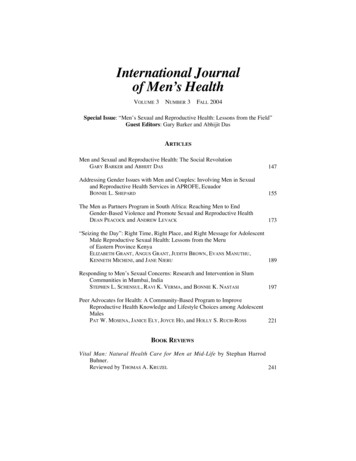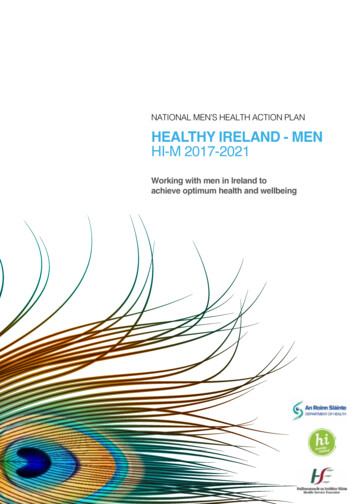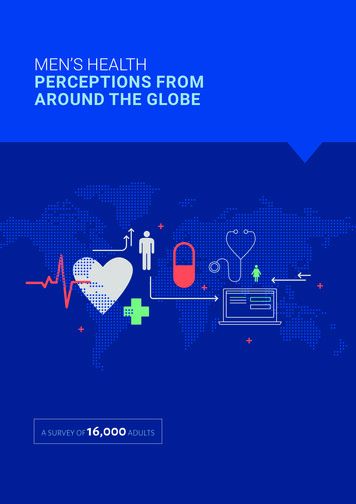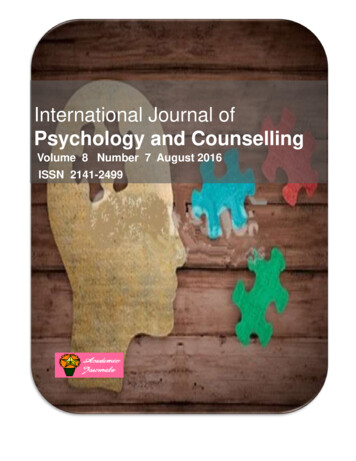
Transcription
International Journalof Men’s HealthVOLUME 3 NUMBER 3 FALL 2004Special Issue: “Men’s Sexual and Reproductive Health: Lessons from the Field”Guest Editors: Gary Barker and Abhijit DasARTICLESMen and Sexual and Reproductive Health: The Social RevolutionGARY BARKER and ABHIJIT DAS147Addressing Gender Issues with Men and Couples: Involving Men in Sexualand Reproductive Health Services in APROFE, EcuadorBONNIE L. SHEPARD155The Men as Partners Program in South Africa: Reaching Men to EndGender-Based Violence and Promote Sexual and Reproductive HealthDEAN PEACOCK and ANDREW LEVACK173“Seizing the Day”: Right Time, Right Place, and Right Message for AdolescentMale Reproductive Sexual Health: Lessons from the Meruof Eastern Province KenyaELIZABETH GRANT, ANGUS GRANT, JUDITH BROWN, EVANS MANUTHU,KENNETH MICHENI, and JANE NJERU189Responding to Men’s Sexual Concerns: Research and Intervention in SlumCommunities in Mumbai, IndiaSTEPHEN L. SCHENSUL, RAVI K. VERMA, and BONNIE K. NASTASI197Peer Advocates for Health: A Community-Based Program to ImproveReproductive Health Knowledge and Lifestyle Choices among AdolescentMalesPAT W. MOSENA, JANICE ELY, JOYCE HO, and HOLLY S. RUCH-ROSS221BOOK REVIEWSVital Man: Natural Health Care for Men at Mid-Life by Stephan HarrodBuhner.Reviewed by THOMAS A. KRUZEL241
END MATTERSAcknowledgment243Index for Volume 3245
Men and Sexual and Reproductive Health:The Social RevolutionGARY BARKERInstituto PromundoRio de Janeiro, RJ, BrasilABHIJIT DASSchool of Public Healthand Community MedicineUniversity of Washington, SeattleAn overview of the state of men’s sexual and reproductive healthsince the 1994 Cairo Conference is presented. Men’s involvementin contraception and family planning, paternal involvement, andviolence toward women are noted. The five articles in this specialissue are introduced. The authors conclude, “Cairo gave us ourblueprint for action. The examples here [the five articles] givevoice to the slow but important progress of engaging men inachieving this vision of true gender equality.”Keywords: International Conference on Population and Development, ICPD, Cairo Conference, men, sexual, reproductive, health,gender revolution, gender equalityIn 1994, delegates from 180 countries met in Cairo at the International Conferenceon Population and Development (ICPD, or the Cairo Conference). These delegatesincluded leading advocates in the field of sexual and reproductive health nominatedby their governments as well as official representatives from national-level governments. Reflecting and deliberating on the field of sexual and reproductive health, thedelegates included in the Plan of Action the following statement:Special efforts should be made to emphasize men’s shared responsibility and promote their active involvement in responsible parenthood, sexual and reproductive behaviour, including familyplanning; maternal and child health; prevention of STIs, includingHIV; . shared control and contribution to family income, chil-Correspondence concerning this article should be sent to Gary Barker, Superintendente/Chief Executive,Instituto Promundo, Rua México, 31/1502, Bloco D, Rio de Janeiro, RJ, Brasil. Electronic mail:g.barker@promundo.org.br.International Journal of Men’s Health, Vol. 3, No. 3, Fall 2004, 147-153. 2004 by the Men’s Studies Press, LLC. All rights reserved.147
BARKER and DASdren’s education, health and nutrition; and recognition . of theequal value of children of both sexes. Male responsibilities in family life must be included in the education of children from the earliest ages. Special emphasis should be placed on the prevention ofviolence against women and children. (United Nations, 1994)While the Cairo Conference was seen as focusing on sexual and reproductivehealth, and much of it did, the Plan of Action was no less than a manifesto for a gender revolution: namely, men should be fully engaged in achieving gender equality intheir family lives and intimate relationships. The Cairo Conference is rightly considered a fundamental moment in the growing international field of promoting men’spositive involvement in sexual and reproductive health. It was, and still is, for thoseof us who are advocates in the field of engaging men in achieving gender equality,our rallying cry.When we consider the domain of reproductive and sexual health, women’s concerns have always been at the forefront. Maternal mortality and morbidity, familyplanning and contraception, safe and legal abortion services, and reproductive tractinfections are issues that have traditionally been associated with women. Men’s concerns seem to appear only when sexually transmitted infections and HIV/AIDS oradolescent health are added to this list, and even then, their inclusion has been limited. Men have sometimes been included in these issues because in many parts of theworld they largely control women’s decision-making related to health care and decisions related to sexuality and reproductive health. Thus some programs have soughtto encourage “appropriate” influence or behavior on the part of men without questioning underlying structural gender inequalities. This limited instrumental approachfor engaging men has been rightly criticized for maintaining the status quo of genderequality.However, the Cairo Plan of Action is a manifesto—not for merely “involving”men in instrumental or small-scale ways—but for true gender equality. The Cairo Planof Action is based on the principles of equal human rights for all, of nondiscriminationand equality of women, and the elimination of all forms of violence and coercion.These principles draw their inspiration from the Universal Declaration of HumanRights, the International Covenant on Economic Social and Cultural Rights, and theConvention on the Elimination of all Forms of Discrimination against Women, amongothers. The Cairo Plan of Action thus represents the application of human rights principles to population and reproductive health-related programming. The call for genderequity and equality and involvement of men is grounded in the principles of humanrights and the belief and assertion that all human beings are equal in dignity and rights.In sum, Cairo does not merely call for engaging or involving men in sexual and reproductive health, but in overturning the inequitable gender order.Eleven years out from the Cairo Conference, the relevant question before us is:Have we achieved the goals set out in the Cairo Plan of Action for engaging menfully in family life and in sexual and reproductive health? The answer is complex, butthe short response is: We’ve come a long way, but we still have a long way to go.If we take men’s use of contraceptives as one indicator of gender inequality, wefind that women continue to bear the burden. Currently, the four methods of contra148
MEN AND SEXUAL AND REPRODUCTIVE HEALTHception that require male cooperation or male initiative are condoms, vasectomy,withdrawal, and periodic abstinence. Worldwide, among women using contraception, about one in every four, or 26 percent, say they are relying on a method usedby their male partner. Seven percent rely on vasectomy, another seven percent oncondoms, and 12 percent rely on either periodic abstinence or withdrawal. Themajority (74 percent) of currently married women worldwide who use any contraceptive method use a female contraceptive method. Of these, female sterilization isthe most common at 33 percent (U.S. Agency for International Development, 2000).In addition, the international HIV/AIDS epidemic has wreaked havoc on individuals, communities, and public health systems; in some countries in sub-SaharanAfrica, HIV prevalence rates in adults has surpassed 30 percent. As of 2002, worldwide HIV infections and AIDS deaths in men outnumber those in women on everycontinent except sub-Saharan Africa. More than 70 percent of HIV infections worldwide occur through sex between men and women. By the end of 1999, 10 millionAfrican men were living with HIV, as compared with 7.5 million infected men in therest of the world combined (UNAIDS, 1999, 2000). In addition to their own risk ofcontracting HIV, men’s greater power—physical, social, and economic—in sexualrelationships and the fact that women are more biologically vulnerable to acquiringHIV during sexual intercourse mean that men’s sexual behavior is key to HIV transmission in women.Furthermore, data suggest that worldwide fathers contribute far less time todirect childcare, although there is tremendous variation across countries and amongmen. Studies from diverse settings find that fathers contribute about one-third toone-fourth of the time that mothers do to direct childcare (Population Council,2001). Of course, even if not as involved in childcare, fathers make decisions aboutuse of household income for children’s well-being, education, and healthcare, inaddition to direct income contributions.Men’s use of physical violence against women is another area where genderequality has not been achieved. More than 30 well-designed studies from around theworld show that between one-fifth and one-half of women interviewed have beensubject to physical violence by a male partner (Heise, 1994). The causes and factorsassociated with men’s use of violence against women are multiple, complex, andinterwoven. But clearly the reasons or underlying factors related to male violenceagainst women are deeply rooted in the social constructions of masculinity andinequalities of power in family life.If the story is mostly negative, there are some bright lights. While large-scaleimpact is yet to be achieved, there is a growing array of program initiatives,research, and policy initiatives seeking to engage men in meaningful ways in reducing gender inequalities. These include clinic-based efforts to engage men, either inprimary healthcare or in specialized reproductive and sexual health clinics. Condomeducation and distribution programs now exist in virtually every country. As aresult, worldwide, men’s knowledge of male condoms is extremely high. Nationalsurveys with married men in 21 developing countries find that 50 percent to 99 percent of men know about condoms (depending on the country) (Drennan, 1998).However, consistent condom use in men’s heterosexual relationships is low and generally associated with casual partners, including sex workers (Finger, 1998). Recent149
BARKER and DAScondom promotion efforts have included social marketing efforts (promoting condom sales at reduced prices through alternative means). Other projects have engagedoutreach workers or peer promoters (men from the same social background engaging other men) and condom distribution to men in special-risk situations, such asmen in the armed forces, truck drivers, and men who are clients of commercial sexworkers (prostitutes), among others.Men’s roles as fathers have also been the subject of international seminars, program development, and advocacy. In 2003, an international summit on fatherhood,held in the U.K., brought together researchers, advocates, and program staff fromnearly 25 countries. In some countries, public health facilities are encouraging mento participate in childbirth. Other initiatives engage men in promoting maternalhealth by educating them on warning signs of maternal complications. UNICEF andother UN agencies have begun to discuss ways to engage men more fully in promoting the health and development of their children. A handful of nongovernmentalorganizations (NGOs) in Latin America and parts of sub-Saharan Africa have startededucational sessions, group discussions, or support groups for fathers, includingboth adult and adolescent fathers. Others have carried out mass media campaigns topromote positive images of men’s involvement in the lives of children, images offathers actively engaged to counter prevailing negative versions.In terms of HIV/AIDS, programs in parts of sub-Saharan Africa and elsewhereare engaging men to prevent mother-to-child transmission, and a few organizationshave started support groups for HIV-positive fathers to promote their own health andwell-being but also to encourage them to support their partners and children.UNAIDS (the UN agency responsible for coordinating UN HIV/AIDS preventionefforts) focused its 2000-2001 World AIDS Campaign on men and boys with theslogan “Men Make a Difference.” This campaign prompted many countries to targetspecific HIV prevention efforts on the sexual behavior of men (UNAIDS, 2000). Insome settings, the silver lining of the HIV/AIDS epidemic has been increased attention of the need to engage men in rethinking their sexual behavior. Some of theseefforts have paid off. Condom use among men has increased in many countries, particularly among younger men.In terms of gender-based violence, in North America and Western Europe,much of the focus has been on providing legal protection for women who have suffered from violence from a male partner. However, since the early 1990s, a numberof important initiatives are working with men. Many of these programs reach menwho have used violence against women (via alternative sentencing, court-mandatedcounseling programs), but more promising still is the number of campaigns and educational activities to engage men in preventing violence against women. One important example, the White Ribbon Campaign, a movement of men working to end violence against women, started in Canada in the early 1990s, is now active in morethan 30 countries.All this is to say that a vibrant and creative field of engaging men in achievinggender equality is emerging. There are enough of us now working with men in promoting gender equality to fill up conference halls. In many rural and urban communities, more men are coming up to fulfill their contraceptive responsibilities, participate in childcare, or speak out about violence against women.150
MEN AND SEXUAL AND REPRODUCTIVE HEALTHHowever, engaging men in these issues is still too often seen as an appendage,as something quaint, in the field of gender studies and women’s rights. There is stillconsiderable debate among advocates in the field about the specific aims of promoting men’s participation in sexual and reproductive health, some of which has alreadybeen alluded to above. There has also been concern among some organizationsworking on behalf of women that new resources going to programs for men’s sexualand reproductive health needs would drain resources from reproductive health programs for women. There are also lingering doubts among some in the field aboutwhether men can fundamentally change.One major challenge that has to be addressed to give full expression to thissocial revolution is to bridge the gap between the personal and the public realm. Thefirst revolution for gender equality, which was spearheaded by the women’s movement, was built on this premise. Men, too, must follow a similar process. Men whoare researchers, program managers, social activists, service providers, and policymakers must carry out this revolution in their personal, political, and professionallives. As men, we need to define a new vision for ourselves—a vision where men canbe egalitarian, respectful, self-critical, concerned, and empathetic. Indeed, the successof the gender revolution will be in not only helping others claim a new social realitybut also being part of the new reality ourselves. Clearly, the behavior of men in theirintimate relations, family life, and sexual and reproductive health is rooted in howsocieties view what it means to be men. This change in mindset cannot be achievedor measured by interventions that simply count numbers of men adopting a particularcontraceptive but by challenging existing social norms and constructing and reproducing new ones. It may also require identifying and reinforcing traditional forms ofcaring and gender-equitable behavior that many men already carry out.With this introduction and within this context, in September 2003 an importantcadre of these programs came together in Washington, D.C., at the “InternationalConference on Men and Reproductive Health” (organized by PATH, EngenderHealth, the Population Reference Bureau, and other partners) to exchange lessonslearned, to push the field, and to take stock of advances and lessons learned since1994. One of the most important results of the conference was an affirmation thatwe have evidence that men can be engaged in sexual and reproductive health inmeaningful ways and that such programs can show impact. The conference includedpresentations from more than 65 program experiences, the vast majority from theSouthern majority world (what some call developing countries) and the vast majority of those with evaluation data. A major trend among many if not most of the presenters was that of working with men in context—that is, finding ways to redressgender inequalities at the level of families, couples, and communities and not justfocusing on individual men in isolation. Indeed, ecological models have in manycases substituted overly simplistic cognitive behavior change models, recognizingthe multiple ways that gender norms are constructed and reconstructed at broadercultural levels, in social institutions, and internalized in individuals.The conference was also an important moment to take stock of our ongoingchallenges. One of those is the fact that there are too few linkages between programs. Programs are too often compartmentalized—for example, focusing on menand maternal health or men and HIV/AIDS or men and gender-based violence pre151
BARKER and DASvention—rather than approaching these issues in an integrated way. Men are complex subjects, contradictory at times, gender-equitable in some domains, andinequitable in others. Their needs are multiple and must be approached with thismultiplicity. Another ongoing challenge is that of translating small-scale programexperiences into policy initiatives. Indeed, too many programs still focus on counting or promoting some narrow aspect of men’s behaviors—for example, how manycontraceptive methods they know or how many men came into a clinic setting, without understanding that real revolution is changing what it means to be a man.However, there were examples of organizations that are now focusing on theroot of the problem: the ways that boys and men are socialized into rigid notions ofmanhood or masculinities. From Nigeria to Brazil to India, a growing body of programs were described that are engaging boys and men in group educational activitiesor carrying out community campaigns or awareness-raising to promote more genderequitable attitudes and behavior on the part of boys and young men. Some programsare starting this as early as age 8. Emerging impact evaluation is finding that theseprograms can in fact change young men’s attitudes and behavior with direct implications for sexual health and reducing gender-based violence (Barker et al., 2004).In this volume, we feature five of the approximately 65 papers presented duringthe Washington conference. These were selected from among program presenterswho submitted a full paper to the journal for consideration; in selecting the articles,a strong emphasis was placed on programs featuring evaluation data and those thatwent beyond mere service provision or outreach activities to include discussionsabout gender norms in general.The five programs presented here are illustrative of the priority regions at theconference—Africa, Latin America, Asia, North America—and of the range of program experiences, including broad-based community outreach to engage men,engaging men in traditional rites of passage settings, in clinic settings, and inschools. Bonnie Shepherd describes APROFE’s experiences in Ecuador of addressing STIs through male clinics and analyses the extent to which interventions canaddress practical and other strategic gender interests—that is, looking at ways notonly to meet the immediate needs of clients but also how to question gender inequalities in relationships. Men’s own gender stereotypical perceptions about themselvesas well as their dominance of women emerge as strong barriers to implementingstrategies to promote gender quality. Dean Peacock and Andrew Levack present theMen-as-Partners initiative in South Africa, a large-scale, multi-pronged approach toengaging men to reduce violence against women as well as HIV. The interventionuses a human rights approach, and the paper describes the changes in knowledge,attitudes, and behavior that were documented among the participants.Elizabeth Grant and her colleagues discuss the possibility of using the traditional seclusion period around male circumcision for health and sexuality educationamong adolescents in Kenya. Using ethnographic methods with a wide variety ofrespondents, they conclude that this tradition offers an appropriate and strategicopportunity to engage young men with messages about adopting healthier lifestylesand rethinking gender norms. The RISHTA project in Mumbai, India, is evaluatingthe use of the Narrative Intervention Model through an integrated community andclinical male health intervention. Stephen Schensul and his colleagues discuss the152
MEN AND SEXUAL AND REPRODUCTIVE HEALTHinterim results of the project in terms of its potential to reduce “risky” sexual behavior and the prevalence of STIs. Finally, Pat Mosena and her colleagues describe apeer education project among African-American adolescents in Chicago. The paperdiscusses how the peer advocates not only emerge as effective outreach agents butalso as potential role models as well. In all five papers, we find promise and remaining challenges. Men are willing to be engaged in discussing gender equality, andprograms are making inroads, but much must be done to take the ideas to scale.In sum, in these program experiences and from the 2003 conference itself, weconclude that the Cairo Plan of Action is still a dream; many of its goals seem distantstill as we look at data on gender-based violence, female infanticide, rates of coercedsex, inconsistent condom use, and limited progress in reducing HIV/AIDS in somesettings. Too few societies, male leaders, and organizations are willing or able yet tofundamentally question rigid views about the roles of men and women. There arealso voices of dissent—conservatives in many settings who would maintain traditional gender inequalities, who do not believe that women and men are equal, or whoespouse narrow religious doctrine and are unwilling to take a full public health andhuman rights perspective. But in communities, cities, villages, and households wherereal people live and negotiate their lives, the gender revolution has started. Cairogave us our blueprint for action. The examples here give voice to the slow but important progress of engaging men in achieving this vision of true gender equality.REFERENCESBarker, G., with Nascimento, M., Segundo, M., & Pulerwitz, J. (2004). How do weknow if men have changed? Promoting and measuring attitude change withyoung men: Lessons learned from Program H in Latin America. In. S. Ruxton(Ed.), Gender equality and men: Learning from practice (pp. 147-161). Oxford,UK: Oxfam.Drennan, M. (1998). Reproductive health: New perspectives on men’s participation.Population Reports, Series J, No. 46.Finger, W. (1998). Condom use increasing. Network, 18(3), 20-23.Heise, L. (1994) Gender-based abuse: The global epidemic. Caderno de SaúdePública, 10(1), 135-45.Population Council. (2001). The unfinished transition: Gender equity: Sharing theresponsibilities of parenthood. A Population Council Issues s papers/transition 4.html.UNAIDS. (1999). Report on the global HIV/AIDS epidemic. Geneva: UNAIDS.Online. (Available online at http://www.unaids.org).UNAIDS. (2000). Men and AIDS: A gendered approach. (Available online atwww.unaids.org/wac/2000/campaign.html).United Nations. (1994). Report of the International Conference on Population andDevelopment. A/CONF.171/13, Cairo, September 5-13, 1994. (Available onlineat www.unfpa.org).U.S. Agency for International Development. (2000) Involving men in sexual andreproductive health: An orientation guide. Washington, DC: Men and Reproductive Health Subcommittee, USAID/InterAgency Gender Working Group.153
Prostate Tales:Men’s Experiences with Prostate CancerBYROSS E. GRAYProstate Tales vividly portrays menwith prostate cancer, bringing theirexperiences out of the shadows wherethey usually lie hidden. Drawing onextensive research interviews, theauthor avoids the usual dry academicreport, instead using stories and dramato display men’s crises, struggles,sorrows, challenges and triumphs. Inthe process he provides readers with astrong visceral connection to thesocial realities of prostate cancer, andreveals how prostate cancer affectsdifferent men in profoundly differentways. This is not a sentimental pieceof work; it aims to tell stories that feeltrue, that honor the courage, humorand strength of individual men whilenot hiding from everyday realities likefear, depression and confusion. Thebook is primarily for men withprostate cancer and their families andfriends, but health professionals willfind it helps them better understand illmen. Prostate Tales is a must read for anyone interested in innovative approaches toeducation and the effective communication of research findings.Ross E. Gray is co-director of the Psychosocial & Behavioral Research Unit at theToronto-Sunnybrook Regional Cancer Centre and assistant professor in theDepartment of Public Health Sciences at the University of Toronto. Gray’s areas ofexpertise include men’s health, qualitative methods, psycho-oncology, and researchbased drama.Prostate TalesMen’s Studies Press, P.O. Box 32, Harriman, TN 37748(1-931342-00-8, print) 14.95(1-931342-01-6, e-version) 10.95To order: www.mensstudies.com/prostate tales
Addressing Gender Issues with Menand Couples: Involving Men in Sexualand Reproductive Health Servicesin APROFE, EcuadorBONNIE L. SHEPARDInternational Health and Human Rights ProgramFrançois-Xavier Bagnoud Center for Health and Human RightsHarvard School of Public HealthThis article is based on a study of the male-involvement initiativeof APROFE (Association for the Benefit of the Ecuadorian Family). It analyzes the lessons learned from a mix of strategies toincrease the number of male clients attending APROFE’s sexualand reproductive health services. Based on provider interviews,the study describes the gender and privacy issues that arise whentreating heterosexual couples in health services and highlights thedynamics between each member of the couple and the serviceprovider in the case of STI diagnosis. The study revealed clearbenefits from male involvement—for both members of the couple.At the same time, the limitations of the health service setting inresolving gender issues that underlie sexual health problems areclear from the findings.Keywords: sexual health, reproductive health, male involvement,gender, sexually transmitted infections, sexual health servicesAuthor acknowledges the collaboration of the APROFE Information, Education, and Communication(IE&C) Department: Miriam Becerra, Director, Abigail Carriél, Aurora Contreras, Maria Quindé; andAugustín Cuesta, Director of Evaluation, APROFE.Correspondence concerning this article should be sent to Bonnie Shepard, 651 Huntington Avenue,Office 702D, Boston, MA 02115. Electronic mail: bshepard@hsph.harvard.edu.International Journal of Men’s Health, Vol. 3, No. 3, Fall 2004, 155-172. 2004 by the Men’s Studies Press, LLC. All rights reserved.155
SHEPARDThis article1focuses on the male-involvement initiative of APROFE (Associationfor the Benefit of the Ecuadorian Family). The initiative began in the late 1990s anddovetailed with APROFE’s efforts to become more financially sustainable, toimprove quality of care, and to increase attention to gender equity throughout itsnational network of 20 reproductive health clinics in 17 cities.In the male-involvement initiative, providers systematically encouraged womento bring their male partners to the service. APROFE then used mass media toencourage other men—both individually and in couples—to use APROFE’s services. As the number of men using the services began to rise dramatically, healthproviders were confronted with new issues related to quality of care, gender, andusers’ right to privacy that had to be dealt with systematically throughout the organization, not just on an ad-hoc basis.The data for this study comes from two main sources: APROFE documents,mainly monitoring data and gender training program reports and minutes,2 and interviews conducted by the author in 2000 with providers of all levels at four clinics: 28semi-structured individual interviews and four group interviews.3 The clinics in thestudy represent distinct Ecuadorian cultural areas and clinic sizes, and the gendertraining team evaluated them all as having a positive response to gender training.The interview guides focused on providers’ experiences with and opinions aboutgender training as well as examples of how the staff incorporated gender issues intotheir daily practice. Male involvement and the issues arising during STI diagnosisemerged as a central theme in the interviews; it was not the original focus of the study.BACKGROUNDWith 13 million inhabitants, Ecuador is one of the smallest and poorest countries inLatin America. In 1998, 62.6% of the population lived below Ecuador’s officialpoverty line, and 26.9% were classified as indigent.4 According to UNICEF statistics for 2000,5 the maternal mortality rate is 130 per 100,000 live births, and infantmortality is at 27. Recent studies in Ecuador show that the fertility rate has fallen to3.4.6 With almost universal primary school enrollment, the literacy rates for adults ofboth sexes are in the high 90s.APROFE’s experiences with promoti
An overview of the state of men’s sexual and reproductive health since the 1994 Cairo Conference is presented. Men’s involvement in contraception and family planning, paternal involvement, and violence toward women are noted. The five articles in this special issue are introduced. The a










